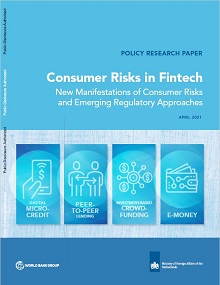
Fintech is increasingly recognized as a key enabler for financial sectors worldwide, enabling more efficient and competitive financial markets while expanding access to finance for traditionally underserved consumers. A critical challenge for policy makers is to harness the benefits and opportunities of fintech while managing its risks, including for consumers. The COVID-19 pandemic further accelerated the widespread transition of consumers to fintech and digital financial services, highlighting their significant benefits while also demonstrating how risks to consumers can increase in times of crisis and economic stress. This paper (1) identifies a range of consumer risks posed by fintech, focusing on four key fintech products (digital microcredit, peer-to-peer lending, investment-based crowdfunding, and e-money) and (2) discusses consumer protection regulatory approaches emerging internationally for policy makers to consider when developing regulatory policy to target such risks. Examples of regulatory approaches are drawn from country examples and international literature. The paper also discusses a range of implementation considerations.
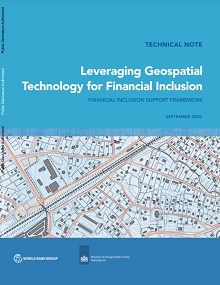
Geospatial technology can be used to map financial access points and assess the distribution of financial services across space, allowing authorities to identify gaps in existing coverage clearly and with much higher precision than is otherwise possible. It can also help to prioritize gaps with respect to various policy objectives as well as design appropriate policy interventions at a subnational level. This note provides financial sector authorities and other stakeholders practical guidance for leveraging geospatial tools to inform financial inclusion policymaking. It draws from the work conducted in Ethiopia, Mozambique and Pakistan under the Financial Inclusion Support Framework (FISF) program.
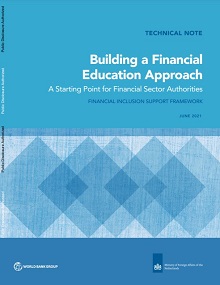
While the importance of financial capability has been studied empirically, questions remain about program effectiveness, whether and how effectively these skills can be taught to consumers, and if financial education programs lead to sustained behavioral changes that improve one’s financial wellness and inclusion. When studied analytically, the results of financial education have been mixed. The objective of this report is to help guide financial sector authorities to build a more effective approach to financial education. The report synthesizes available resources and complements existing knowledge about financial education. It also explores the appropriate role for financial sector authorities within financial education and outlines a practical approach for financial sector authorities who choose to develop financial education agendas or strategies. Lastly, the report provides an overview of the best tools and practices to improve the effectiveness of financial education initiatives.
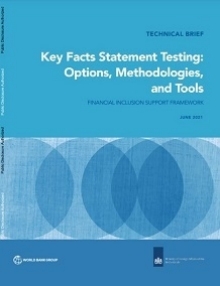
Disclosure and transparency are cornerstones of financial consumer protection and are key drivers of trust in the financial system. A key facts statement (KFS) is an important tool to improve transparency and disclosure of information for financial products through the adoption of a standardized format that is designed to convey information in a simple and easy-to-understand manner. The design of a KFS is central to its success. Testing a KFS is an important part of the design process and ensures that a KFS is designed in a way that reduces information asymmetry between consumers and providers of financial services most effectively. The purpose of rigorously testing a KFS is to assess how different versions of a KFS influence the understanding of product terms and conditions, as well as the consumer decision-making process. KFS testing can identify and recommend improvements to the KFS. It does so by testing: (1) participants’ design and content preferences; (2) the information on which they typically focus; (3) questions that arise with regard to the content and design; (4) the amount of information that participants can comprehend and process; and (5) how different presentations of information alter participants’ decision-making. This report recommends prioritizing focus groups as a tool that can address the majority of KFS-testing needs.
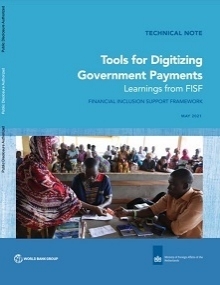
This note documents the experience of several countries that leveraged these tools under the Financial Inclusion Support Framework (FISF) program. FISF is a World Bank Group initiative that aims to accelerate and increase the effectiveness of reforms and other country-led actions to achieve national financial inclusion goals. In this context, FISF has supported, to varying degrees, the digitization of government payments in Côte d’Ivoire, Indonesia, Mozambique, Vietnam, and Zambia. The rest of the note is structured as follows: Section II covers a survey of retail payment costs conducted in Pakistan. Section III documents the government payment mapping exercise undertaken in Côte d’Ivoire, while section IV discusses the resulting roadmap for implementation. Section V presents some implementation challenges and learnings in digitizing government payments in FISF countries.
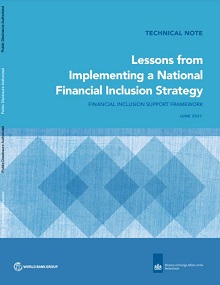
A national financial-inclusion strategy (NFIS) helps policy makers, in coordination with a wide range of stakeholders, define objectives and outline a set of impactful, sequenced actions to accelerate progress toward achieving financial-inclusion goals. Achieving greater financial inclusion requires a deliberate, coordinated approach to identify barriers and opportunities, and a platform for diverse stakeholders to coordinate efforts to achieve shared financial-inclusion objectives. NFIS implementation typically involves operationalizing governance arrangements to oversee implementation, establishing a framework for monitoring and evaluation (M&E) to capture progress regularly, implementing action plans to achieve financial-inclusion targets, and making necessary adjustments to address changing landscapes. In 2018, the World Bank Group (WBG) released a toolkit that provides financial-sector authorities and other stakeholders with practical guidance on developing and operationalizing an NFIS. After launching an NFIS, many factors influence and shape progress and success, and no two countries travel the same path during NFIS implementation. This note aims to build on existing NFIS knowledge by sharing insights that have helped improve implementation postlaunch. When used together with the WBG NFIS Toolkit, this note aims to support countries that are working to draft, launch, and implement an NFIS effectively.
Core to an effective financial consumer protection framework is an accessible and efficient recourse mechanism that allows consumers both to know and to assert their rights to have their complaints addressed and resolved in a transparent and just way within a reasonable timeframe. Complaints handling mechanisms are especially important for low-income and vulnerable financial consumers, to whom timely and effective recourse processes can have a decisive influence over their trust in their financial service provider (FSP) and in the financial sector in general. Increased trust contributes to consumers' uptake and sustained usage of financial services and, consequently, their economic livelihoods.
This note discusses emerging international approaches for regulating design and distribution of retail banking products. Such products include deposit, credit, and payment products, being the products that new financial consumers typically acquire first. Policy makers are finding that financial consumer protection measures implemented to date, such as disclosure requirements, while still important, are insufficient to protect consumers against all key risks. Anticipating new or changing risks to consumers has also become more difficult for regulators given rapid financial sector innovation.
The report discusses key policy issues that enable and constrain digital savings market development and offers policy considerations within the context of the G20’s High-Level Principles for Digital Financial Inclusion. Based on current market observations, three policy considerations seem most important for facilitating digital savings account deployments: Enable banking institutions to pursue digital savings partnerships with nonbank entities. Support the development of interoperability between banks and nonbank e-money issuers. Harmonize customer due diligence standards for emoney wallets and low-risk bank deposits
China has achieved remarkable success in financial inclusion. China’s rate of account ownership – a basic metric of financial inclusion – has increased significantly in the past two decades and is now on par with that of other G-20 countries. Traditional financial service providers have dramatically increased the reach of the formal financial sector, including through the world’s largest agent banking network. China has also been an established leader in the fintech revolution, with new technology-driven providers transforming how millions of Chinese consumers make payments, borrow, save, invest, and insure themselves against risk.
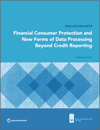
New sources of data and new ways to process data have contributed to an ongoing expansion in the availability of digital financial services. Such data can be used to design and market customer-centric products, create credit scores for consumers with limited credit histories, meet and facilitate know-your-customer requirements, and minimize the risk of fraud. Yet a great variety of personal information may be processed in this context. This discussion note provides an overview of benefits and risks arising from the use of new types of data and identifies areas for further research.
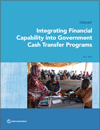
Developing financial knowledge and skills among beneficiaries of government cash transfer programs has emerged as a strategic policy objective around the world as it greatly enhances effectiveness of such programs and helps tackle chronic poverty and insecurity in low-income and poor households. This toolkit analyzes the benefits of such integrated programs, sequences a recommended roadmap of the necessary steps, and suggests a design and implementation methodology with reference to the global best practices.
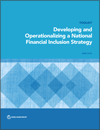
Developing a national financial inclusion strategy (NFIS) can help countries chart a clear and coordinated path toward greater financial inclusion. This toolkit provides practical guidance on developing and operationalizing a NFIS. The toolkit draws on over 20 country experiences and is informed by the World Bank Group’s role as a technical partner in NFIS development and operationalization in a diverse range of country contexts.
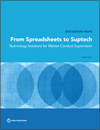
Effective market conduct supervision is critical to ensuring that financial consumers are protected from unfair business practices and provided with clear information. This discussion note examines the use of Suptech (supervisory technology) solutions to improve market conduct supervision. It also provides case studies of Suptech applications in the U.S, Lithuania, and Brazil, and highlights the risks and challenges that may arise with Suptech.
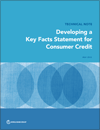
This technical note provides practical guidance to policy makers seeking to develop key facts statements (KFSs) for consumer credit products. Misleading or incomplete information on fees and risks can result in consumers choosing products not well-suited to their needs, potentially harmful to consumer welfare. KFSs provide key information on terms, conditions, fees, and total costs, in a clear standardized format. The note shares the key principles, international good practices, and lessons learned in developing KFSs that can help achieve better consumer comprehension.
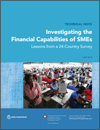
Improving the financial capability of SME decision makers can significantly boost SME growth and stimulate sustainable economic development in low- and middle-income countries, especially in areas with large informal job sectors. This survey report yields a comprehensive view of SME financial capability, identifies clusters of vulnerable SMEs, and recommends areas of early stage policy intervention and support to help SMEs improve performance and attract investment.
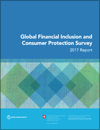
This report presents the main findings of the 2017 Global Financial Inclusion & Consumer Protection (FICP) Survey. The 2017 Global FICP Survey tracks the prevalence of key policy, legal, regulatory, and supervisory efforts to advance financial inclusion and financial consumer protection. Financial sector authorities in 124 jurisdictions - representing 141 economies and more than 90 percent of the world’s unbanked adult population - responded to the 2017 Global FICP Survey. See also: 2013 Global CPFL Survey (available below).
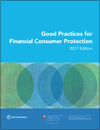
Since the 2012 edition (available below), international guidance and country practices regarding financial consumer protection have substantially evolved. The 2017 Good Practices is a comprehensive reference and assessment tool for policymakers that consolidates the latest research, international guidance, and country examples. A thorough update of the previous edition, this guide emphasizes implementation aspects and expands upon priority areas such as supervisory techniques, effective disclosure, and digital finance.
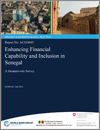
Despite some progress made toward financial inclusion priorities in Senegal in the past few years, over 80% of Senegalese adults remain unbanked. This study shows that a lack of financial capability, especially among women, is a key challenge and suggests concrete actions to close the identified gaps. Also available in French.
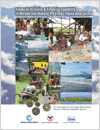
Bank of Papua New Guinea (BPNG), with the technical assistance from the World Bank, conducted the first population level study on Financial Inclusion and Financial Capability in PNG to examine how women and men make financial decisions on behalf of their households. The initial findings from Morobe and Madang provinces call for improving financial service infrastructure in rural areas of PNG and developing targeted financial education programs for women.
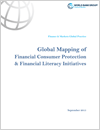
This overview of consumer protection and financial literacy (CPFL) initiatives lists the international organizations, development banks, bilateral donors, support networks and associations, and private foundations that actively pursue development and strengthening of CPFL frameworks around the globe. In each case, we attempt to provide specifics on the scope of policy work, committed resources, and key results achieved so far.

Institutional arrangements are one of the key determinants of efficiency and ultimate success of any framework for financial consumer protection (FCP). This note is intended to assist policymakers, regulators, and supervisors seeking to establish new institutional arrangements or strengthen the existing ones in their respective countries. The note discusses importance of FCP, main models around the world, their advantages and disadvantages, as well as principal challenges faced by FCP agencies.
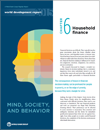
Chapter Six of the new World Development Report 2015 dicusses factors of human behavior in the context of household finance. Financial decisions are difficult and have profound effects on our lives, especially for poor people who often lack a margin of error. Recent research revealed systematic biases in humans, and markets work to either help us overcome or exacerbate them. This chapter explores ways to address behavioral constraints in family or household financial planning and design policy interventions that help consumers make better financial decisions.
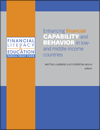
The final output of the Russia Trust Fund on Financial Literacy and Education, this volume presents the results of the Trust Fund’s pilot projects - some truly pioneering research in financial capacity building, including methods to increase financial awareness and encourage safer financial behavior. Such tools and methods enable access to financial literacy for a much wider population, with potentially greater impact than what has been achieved using the more conventional means.
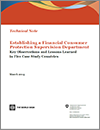
This technical note assists regulators seeking to establish a financial consumer protection supervision department within the main financial regulatory body of a country. The note provides concrete, practical information and lessons drawn from the experiences of five countries: Armenia, the Czech Republic, Ireland, Peru, and Portugal. It covers topics such as supervisory agenda, organizational structure, supervisory activities, relationship with prudential supervision, and staffing needs. Also available: Russian version.
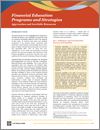
This brief provides practical guidance to countries seeking to develop effective financial education programs and strategies. Recent evaluations of a number of financial education programs reported widely ranging outcomes - from evidence of effectiveness to mixed evidence or none. The quality of design of such programs is therefore crucial. This brief outlines the essential operational steps for maximizing the benefits of financial education initiatives. Annexes feature conclusions of recently completed impact evaluation studies.

This publication monitors progress by the governments of the world’s major economies in implementing national strategies for improving financial education. It includes contributions by twenty one G20 member economies, invited countries and the European Union. It highlights the main features of country experiences and in particular the rationale for the development of national strategies, their status in the countries covered in the publication, their main objectives and their founding elements. It also points to the different governing structures established to design and implement national strategies, the role of stakeholders, and their main implementing directions and challenges.
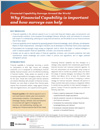
Financial capability is increasingly becoming a priority for policy makers as it is recognized to contribute to the financial stability, financial inclusion, and to the effective functioning of financial markets. This note outlines and compares key approaches to measuring financial capability and the external factors that may affect it, offering policy makers a broad range of options to consider when developing their research and policy objectives.
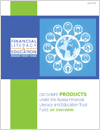
OECD/INFE has been a major contributor to the activites of the RTF work program on financial capability and education, drawing on a decade of experience. This overview outlines the systemic approach undertaken by OECD/INFE and the partners to study and disseminate successful policies and practices in financial education from around the world, and develop criteria, principles, guidelines, and tools for effective strategies. A 3-part series on principles and guidelines is available in the Policies & Practices section.
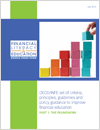
This high-level framework for national strategies in financial education offer global guidance to develop appropriate and coordinated financial education policies at a national level. It details the critical stages and key factors in crafting effective strategies. Its principles were endorsed by G20 Leaders in June 2012 and supported by APEC Finance Ministers in August 2012.
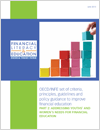
An integral component of national strategies for financial education is the identification and outreaching of target audiences with special needs for financial education. The OECD/INFE identified back in 2009/10 youth and women as such groups, and this was confirmed by G20 leaders in 2012. Related guidelines and policy guidance are presented in this 2nd part of the OECD/INFE principles series.
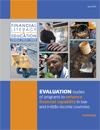
This booklet summarizes the World Bank's study of field evaluations and highlights the lessons learned from their implementation. The evaluations were selected based on their innovative nature and potential to develop and illustrate solutions to methodological challenges.
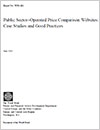
This technical note is intended to provide regulators with concrete, practical information on operating price-comparison websites and the strategic considerations necessary to take into account when designing such sites. The technical note examines price-comparison websites operated by public sector entities in Canada, Hungary, Ireland, Malaysia, Mexico, Norway, and the United Kingdom.
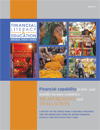
This report provides an overview of the work program implemented by the World Bank and funded by the Russia Financial Literacy and Education Trust Fund (RTF). It highlights the significant contributions of this work program to the conceptual development and measurement of financial capability and the evaluation of the results.
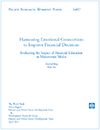
This study measures the effects of a financial literacy message delivered through a soap opera called "Scandal!" to [missing] low-income households in South Africa. The study finds that viewers who watched the storyline related to financial literacy showed significant improvements in financial knowledge and behavior, including greater likelihood to borrow from formal sources and reduced gambling.

This technical note provides a case study on institutional arrangements for market conduct supervision in Armenia including lessons learned for small economies. It describes how market conduct supervision is organized within the Central Bank of Armenia, what supervisory tools are being used and how they are applied as well as enforcement actions taken. Finally lessons learned and challenges are presented based on the Armenian experience.

This review identifies, compares, and contrasts existing measurement approaches in the area of financial literacy and capability, and in the related areas of financial inclusion and financial consumer protection. The review is intended to be a reference tool for policy makers, practitioners, and researchers interested in conducting a survey on these topics.
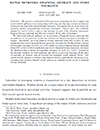
This study examined the effects of financial literacy training as well as targeted discount vouchers in encouraging farmers in rural India and Kenya to take up index-based weather insurance. The study found that while the vouchers only had effects on direct recipients, the financial literacy materials, delivered through a comic book, had positive spillover effects in higher uptake of drought insurance.
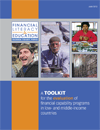
The Russia Trust Fund's Toolkit focuses on the specific challenges of evaluating financial capability interventions in the low-income and middle-income country setting. This Toolkit provides a practical guide to the various aspects of conducting such evaluations that address the specific needs of financial capability programs in the developing world. Also available: Summary (PDF)
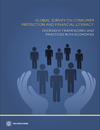
This report summarizes the results of the Global Survey on Consumer Protection and Financial Literacy conducted by the World Bank in 2013. The survey assessed the global status of financial consumer protection regulation and oversight frameworks in line with the G20 Principles and World Bank Good Practices. Using the data from an earlier survey completed in 2010, the report evaluates progress in a number of areas. In contrast with the previous limited Results Brief, this expanded version has additional analysis, and contains the survey data tables as annexes.
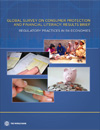
This limited Results Brief outlines the findings of the Global Survey on the financial consumer protection legal and institutional arrangements in relation to deposit and credit services in 114 countries. The full report, Global Survey on Consumer Protection and Financial Literacy - Oversight Frameworks and Practices in 114 Economies (PDF), provides additional analysis and contains the survey data tables as annexes.

The World Bank's Good Practices (2012) provide a comprehensive diagnostic tool to help identify the consumer protection issues in all parts of the financial sector. They are based on international benchmarks, such as the principles released by the Basel Committee, IOSCO and IAIS, and OECD recommendations as well as directives, laws, regulations and codes of business practices from countries worldwide.
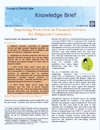
Optimal consumer protection in financial services and high consumer financial capability are at the heart of a financial sector in Bulgaria that aims to be effective, competitive, and fair. This brief details the policy revisions in Bulgaria that resulted from the World Bank's 2009 report and 2010 survey.
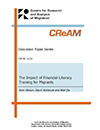
This paper presents the results of a randomized experiment designed to measure the impact of providing financial literacy training to migrant workers in Australia and New Zealand. The training increased financial knowledge and information seeking behavior and reduced the risk of switching to costlier remittance products.
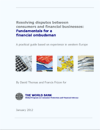
Financial ombudsmen can help increase consumer confidence in financial services, and hence also benefit financial businesses by helping markets to improve and grow. This report outlines the fundamentals for the creation of an independent and effective financial ombudsman. It describes how financial ombudsmen have grown in the developed financial market of Western Europe, and provides case studies.
Core to an effective financial consumer protection framework is an accessible and efficient recourse mechanism that allows consumers both to know and to assert their rights to have their complaints addressed and resolved in a transparent and just way within a reasonable timeframe. Complaints handling mechanisms are especially important for low-income and vulnerable financial consumers, to whom timely and effective recourse processes can have a decisive influence over their trust in their financial service provider (FSP) and in the financial sector in general. Increased trust contributes to consumers' uptake and sustained usage of financial services and, consequently, their economic livelihoods.
This note discusses emerging international approaches for regulating design and distribution of retail banking products. Such products include deposit, credit, and payment products, being the products that new financial consumers typically acquire first. Policy makers are finding that financial consumer protection measures implemented to date, such as disclosure requirements, while still important, are insufficient to protect consumers against all key risks. Anticipating new or changing risks to consumers has also become more difficult for regulators given rapid financial sector innovation.
The report discusses key policy issues that enable and constrain digital savings market development and offers policy considerations within the context of the G20’s High-Level Principles for Digital Financial Inclusion. Based on current market observations, three policy considerations seem most important for facilitating digital savings account deployments: Enable banking institutions to pursue digital savings partnerships with nonbank entities. Support the development of interoperability between banks and nonbank e-money issuers. Harmonize customer due diligence standards for emoney wallets and low-risk bank deposits
China has achieved remarkable success in financial inclusion. China’s rate of account ownership – a basic metric of financial inclusion – has increased significantly in the past two decades and is now on par with that of other G-20 countries. Traditional financial service providers have dramatically increased the reach of the formal financial sector, including through the world’s largest agent banking network. China has also been an established leader in the fintech revolution, with new technology-driven providers transforming how millions of Chinese consumers make payments, borrow, save, invest, and insure themselves against risk.